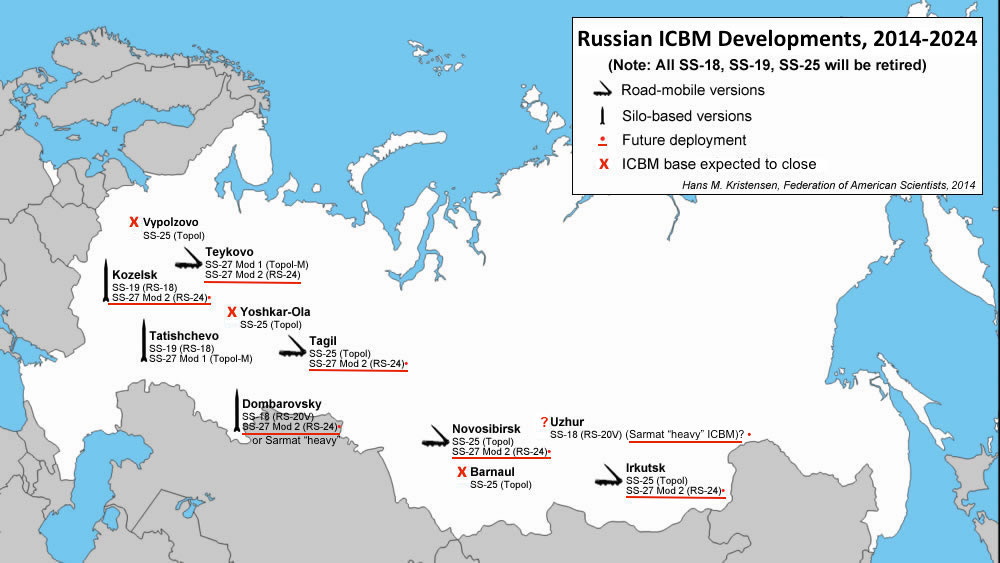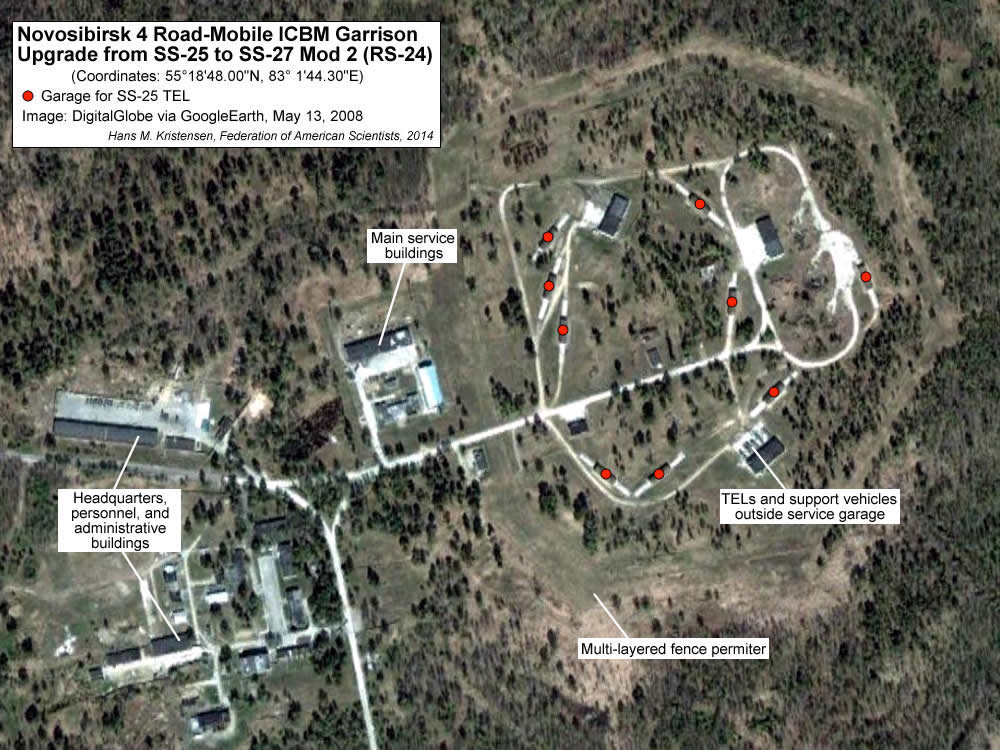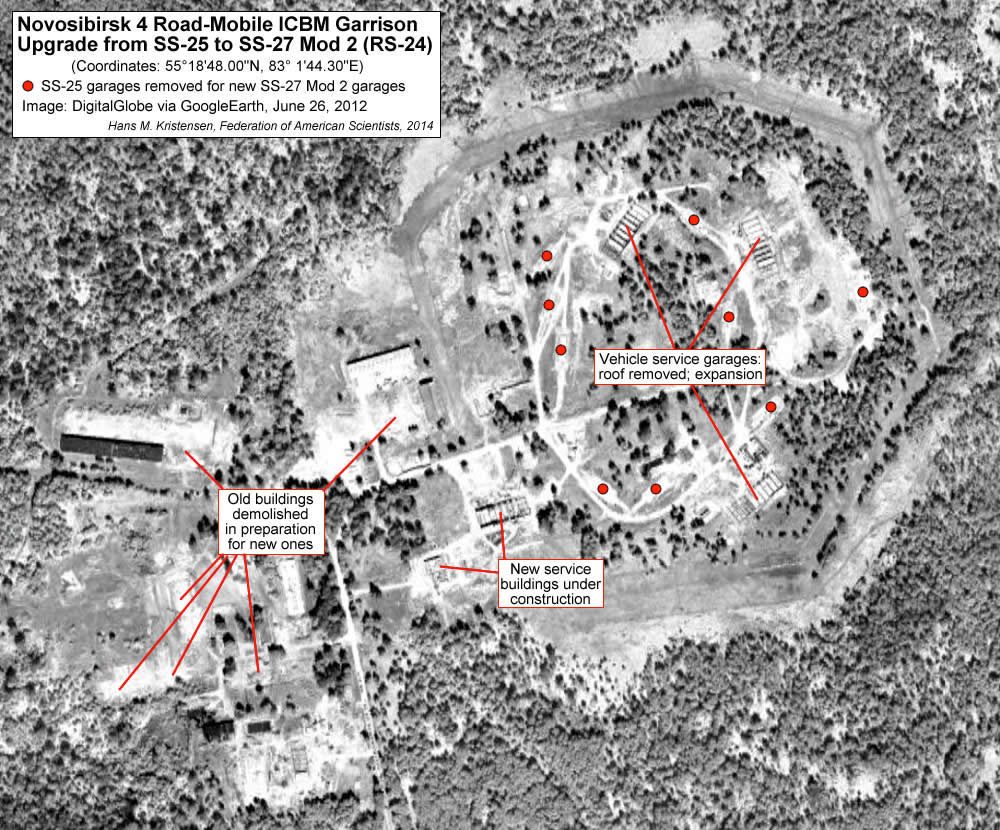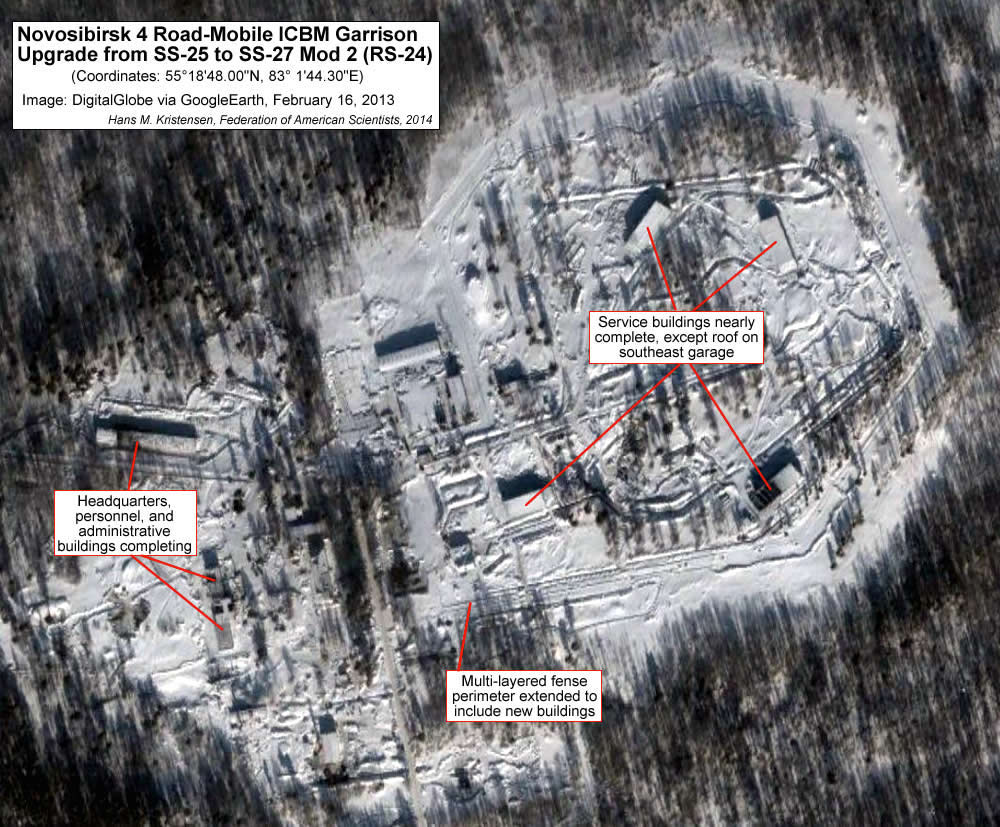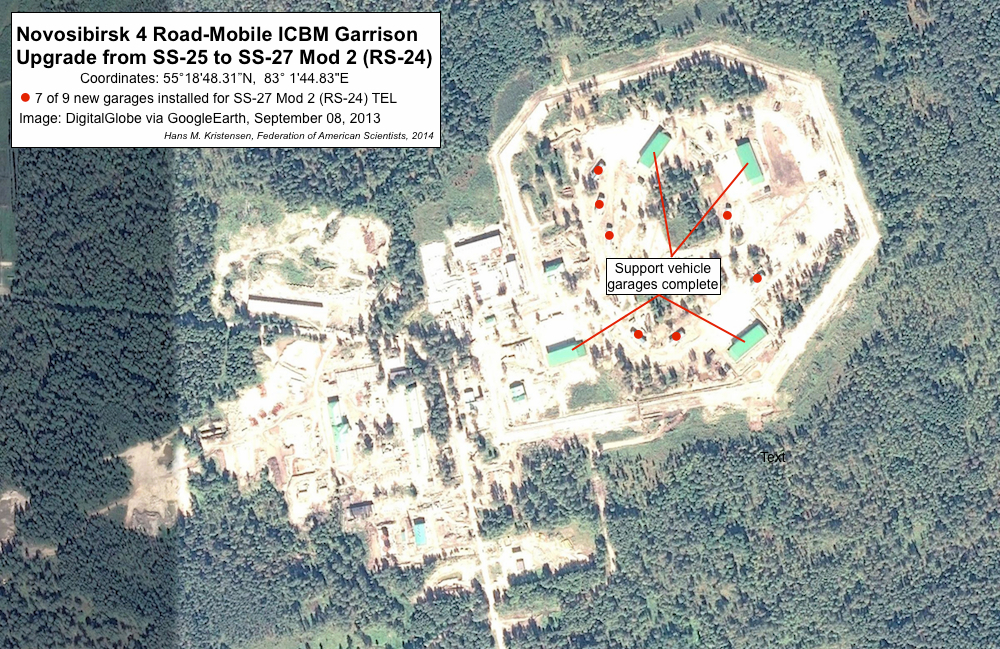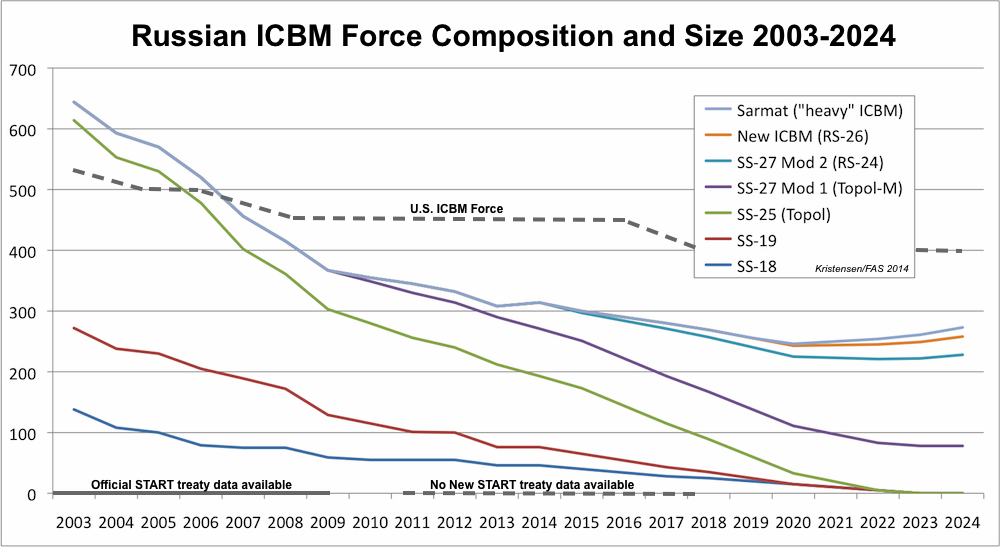Russian ICBM Force Modernization: Arms Control Please!
By Hans M. Kristensen
In our Nuclear Notebook on Russian nuclear forces from March this year, Robert S. Norris and I described the significant upgrade that’s underway in Russia’s force of land-based intercontinental ballistic missiles (ICBMs).
Over the next decade, all Soviet-era ICBMs will be retired and replaced with a smaller force consisting of mainly five variants of one missile: the SS-27.
After more than a decade-and-a-half of introduction, the number of SS-27s now makes up a third of the ICBM force. By 2016, SS-27s will make up more than half of the force, and by 2024 all the Soviet-era ICBMs will be gone.
The new force will be smaller and carry fewer nuclear warheads than the old, but a greater portion of the remaining warheads will be on missiles carried on mobile launchers.
The big unknowns are just how many SS-27s Russia plans to produce and deploy, and how many new (RS-26 and Sarmat “heavy”) ICBMs will be introduced. Without the new systems or increased production of the old, Russia’s ICBM force would probably level out just below 250 missiles by 2024. In comparison, the U.S. Air Force plans to retain 400 ICBMs.
This disparity and the existence of a large U.S. reserve of extra warheads that can be “uploaded” onto deployed missiles to increase the arsenal if necessary drive top-heavy ICBM planning in the Russian military which seeks to maximize the number of warheads on each missile to compensate for the disparity and keep some degree of overall parity with the United States.
This dilemma suggests the importance of reaching a new agreement to reduce the number deployed strategic warheads and missiles. A reduction of “up to one-third” of the current force, as recently endorsed by the new U.S. nuclear employment strategy, would be a win for both Russia and the United States. It would allow both countries to trim excess nuclear capacity and save billions of dollars in the process.
Phased Deployment
Introduction of the SS-27 has come in two phases. The first phase, which last from 1997 to 2013, involved deployed the single-warhead type (SS-27 Mod 1; Topol-M) in silos and on road-mobile launchers. The silo-based version was deployed first, replacing SS-19s in the 60th Missile Division at the Tatishchevo missile field outside Saratov. The deployment was completed in 2013 (see picture below) after 60 SS-27 Mod 1 missiles had been lowered into former SS-19 silos at a slow pace of less than 4 missile in average per year.
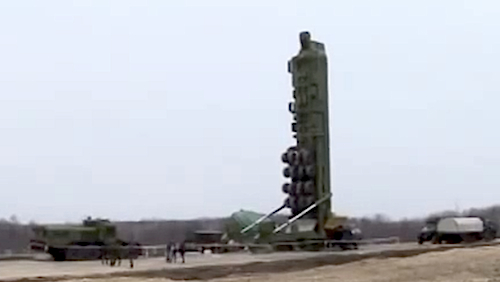
An SS-27 Mod 1 (Topol-M) is lowered into a former SS-19 silo at the Tatishchevo missile field outside Saratov.
In 2006, deployment of the first road-mobile SS-27 Mod 1 began with the 54th Guards Missile Division at Teykovo northeast of Moscow. The deployment was completed in 2010 with 18 missiles in two regiments.
With completion of the SS-27 Mod 1 deployment of 78 missiles, efforts have since shifted to deployment of a MIRVed version of the SS-27, known as SS-27 Mod 2, or RS-24 Yars in Russia. It is essentially the same missile as the Mod 1 version except the payload “bus” has been modified to carry multiple independently targetable warheads (MIRV). Each missile is thought to be able to carry up to 4 warheads, although there is uncertainty about what the maximum capacity is (but it is not 10 warheads, as often claimed in Russian news media).
The first road-mobile SS-27 Mod 2s were deployed at Teykovo in 2010, alongside the SS-27 Mod 1s already deployed there. For the foreseeable future, all new Russian ICBM deployments will be of MIRVed versions of the SS-27, although a “new ICBM” and a “heavy ICBM” are also being developed.
In 2012, preparations began for introduction of SS-27 Mod 2 at three additional missile divisions. At the 28th Missile Guards Division at Kozelsk southwest of Moscow, conversion of former SS-19 silos (see picture below) to carry the SS-27 Mod 2 is underway with deployed of the first regiment (10 missiles) scheduled this year. How many missiles will be deployed at Kozelsk is unclear. The missile field originally included 60 SS-19 silos but half have been demolished so perhaps the plan is for three regiments with 30 SS-27 Mod 2 missiles. After silo-based RS-24s are installed at Kozelsk, deployment will follow at the 13th Missile Division at Dombarovsky, replacing the SS-18s currently deployed there.

A former SS-19 ICBM silo at Kozelsk is being upgraded to receive the SS-27 Mod 2 (RS-24 Yars) ICBM. Deployment begins this year.
In addition to Kozelsk, preparations are also underway to upgrade three road-mobile SS-25 garrisons to the SS-27 Mod 2. At this point, this includes the 51st Missile Guards Division at Irkutsk, the 39th Guards Missile Division at Novosibirsk, and the 42nd Missile Division at Nizhniy Tagil.
Preparation started at Novosibirsk in 2012, where two of four garrisons are under conversion. One of these (Novosibirsk 4; see further description below) is nearly complete. Conversion started at Irkutsk in 2012 with dismantling of SS-25 garages at one of the three remaining garrisons. At Tagil, SS-27 Mod 2 introduction is underway at two of three remaining SS-25 garrisons. In December 2013, the first SS-27 Mod 2 regiment at Novosibirsk (9 launchers) and one partially equipped (6 launchers) regiment at Tagil were put on “experimental combat duty.”
The remaining SS-25 divisions – the 7th Guards Missile Division at Vypolsovo, the 14th Missile Division at Yoshkar-Ola, and the 35th Missile Division at Barnaul – have not been mentioned for SS-27 Mod 2 upgrade and seem destined for retirement. One of the three garrisons at Yoshkar-Ola has been inactivated.
Below follows a more detailed description of the upgrade to SS-27 Mod 2 (RS-24) underway at Novosibirsk.
SS-27 Upgrade at Novosibirsk
As mentioned above, the 39th Guards Missile Division at Novosibirsk is being upgraded from the solid-fuel road-mobile single-warhead SS-25 ICBM to the solid-fuel road-mobile MIRVed SS-27 Mod 2 (RS-24). A series of unique satellite images provided by Digital Globe to Google Earth show the upgrade of one of four garrisons (Novosibirsk 4) between 2008 and 2013.
The first image from May 2008 (see below) shows the garrison with all nine garages for SS-25 road-mobile launchers (TELs) clearly visible inside the multi-layered fence perimeter. Several TELs and support vehicles are parked outside one of three service buildings.
The second image from June 2012 (see below) shows that all nine TEL garages have been dismantled and the roof is missing on the three service vehicle buildings. Two new service buildings are under construction just outside the fence perimeter and several buildings have been demolished in preparation for new administrative and technical buildings.
The third image, taken in February 2013, shows the fence perimeter at the southwest corner of the garrison has been extended westward to include the new service buildings. This extension is similar to the change that was made at Teykovo when two garrisons were equipped with the SS-27 Mod 2 (RS-24). The image indicates that support vehicle garages inside the fence perimeter are almost done, and that administrative and technical buildings outside the perimeter have been added.
The fourth image (see below), from September 2013, shows installation of new TEL garages for the SS-27 Mod 2 (RS-24) launchers well underway, with seven of eventually nine garages visible. The green roofs of the four large service vehicle garages are clearly visible, as are the new administrative and technical building outside the fence perimeter.
The Future ICBM Force
Predicting the size and composition of the Russian ICBM force structure into the future comes with a fair amount of uncertainty because Russia doesn’t release official data on its nuclear forces, because U.S. intelligence agencies no longer publish detailed information on Russian nuclear forces, and because Russian aggregate data under the New START treaty is not made public (unlike during the previous START treaty). Nonetheless, based on previous history, scattered officials statements, and news media reports, it is possible to make a rough projection of how the Russian ICBM might evolve over the next decade (see graph below).
This shows that the size of the Russian ICBM force dropped below the size of the U.S. ICBM force in 2007 mainly due to the rapid reduction of the SS-25 ICBM. By the early 2020s, according to recent announcements by Russian military officials, all SS-18, SS-19, and SS-25 ICBMs will be gone. Development of a new ICBM – apparently yet another version of the SS-27 – known in Russia as the RS-26 is underway for possible introduction in 2015. And a new liquid-fuel “heavy” ICBM known in Russia as the Sarmat, and nicknamed “Son of Satan” because it apparently is intended as a replacement for the SS-18 (which was code-named Satan by the United States and NATO) is said to be scheduled for introduction around 2020.
This development would leave a Russian ICBM force structure based on five modifications of the solid-fuel SS-27 (silo- and mobile-based SS-27 Mod 1; silo- and mobile-based SS-27 Mod 2 (RS-24); and the RS-26) and the liquid-fuel Sarmat with a large payload – either MIRV or some advanced payload to evade missile defense systems. Although the future force will be smaller, a greater portion of it will be MIRVed – up from approximately 36 percent today to roughly 70 percent by 2024. This increasingly top-heavy ICBM force is bad for U.S-Russian strategic stability.
I hope I’m mistaken about the possible increase in the Russian ICBM force after 2020. In fact, it seems more likely that the Russian economy will not be able to support the production and deployment of “over 400 modern land and sea-based inter-continental ballistic missiles” that President Putin promised in 2012. But if I’m not mistaken, then it would be an immensely important development. Not that I think it would matter that much militarily in the foreseeable future or necessarily signal a new arms race. But it would be a significant break with the trend we have seen in Russian nuclear forces since the end of the Cold War, and it would create serious problems for the stability of the Non-Proliferation Treaty regime. It is important that the Russian government provides more transparency about its nuclear force structure plans and demonstrate that it is not planning to increase its ICBM force shortly after the New START treaty expires in 2018.
Regardless, there is an increasing need for Russia and the United States to make more progress on nuclear arms control. Notwithstanding its important verification regime, the New START treaty was too modest to impress anyone (it has no real effect on Russian nuclear forces and it is so modest that the United States plans to keep emptied ICBM silos instead of destroying them). A good start would be a new arms control agreement with “up to one-third” fewer deployed strategic warheads and launchers than permitted by the New START Treaty, as recently endorsed by the U.S. Nuclear Employment Strategy. Such an agreement would force Russia to reduce the warhead loading on its ICBMs and force the United States to reduce its large ICBM force.
It is also important that the United States and Russia revisit the MIRV-ban. The START II treaty, which was signed but not ratified and later abandoned by Vladimir Putin and George W. Bush in 2002, included a ban on MIRVed ICBMs. Apart from reducing the warheads the two nuclear superpowers would be able to launch agains each other, a MIRV ban would also serve the vital role of discouraging other nuclear-armed states from deploying multiple warheads on their ballistic missiles in the future, which could otherwise significantly increase their nuclear arsenals and result in regional arms races.
Trying to pursue new reductions in excessive and expensive nuclear forces and avoid counterproductive modernization programs is perhaps even more important now given the souring relations caused by the crisis in Ukraine. Don’t forget: even at the height of the Cold War it was possible – in fact essential – to reach nuclear arms control agreements.
Additional background: Russian Nuclear Forces, 2014 | Russian SSBN Fleet
This publication was made possible by a grant from the Ploughshares Fund. The statements made and views expressed are solely the responsibility of the author.
A military depot in central Belarus has recently been upgraded with additional security perimeters and an access point that indicate it could be intended for housing Russian nuclear warheads for Belarus’ Russia-supplied Iskander missile launchers.
The Indian government announced yesterday that it had conducted the first flight test of its Agni-5 ballistic missile “with Multiple Independently Targetable Re-Entry Vehicle (MIRV) technology.
While many are rightly concerned about Russia’s development of new nuclear-capable systems, fears of substantial nuclear increase may be overblown.
Despite modernization of Russian nuclear forces and warnings about an increase of especially shorter-range non-strategic warheads, we do not yet see such an increase as far as open sources indicate.
